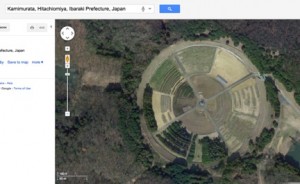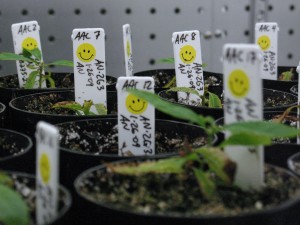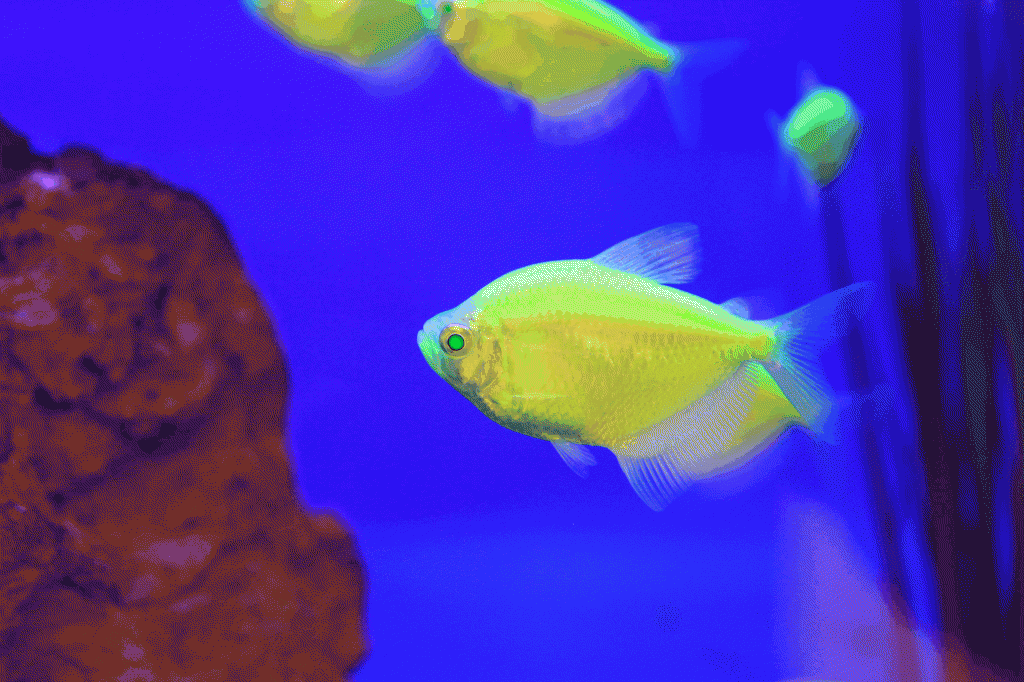The newly opened Center for PostNatural History in Pittsburgh is the first museum that seeks to catalog man-made biological organisms. The man behind the museum is not a scientist, but an artist, one member of a growing DIY community that is exploring–and making–a new meaning of life as we know it. Read the story below or watch audio slideshows about the stories behind five of the species housed by the Center here.
What’s the difference between a green fluorescent bunny and a GloFish®? One is furry: the invention of an American bio-artist. The other is a trademarked product from Singapore, outlawed in every country but the United States. They share a single gene responsible for their bioluminescence originating in the jellyfish, Aequorea Victoria.
On Pittsburgh’s Penn Avenue, between an Italian sub shop and a Vietnamese Pho restaurant, a storefront labeled “Center for PostNatural History” goes quietly unnoticed.
In the dimly lit exhibit hall, glass vitrines house familiar looking specimens: an array of fruit flies impaled on mounting pins; a flask of live, fluttering Sea Monkeys; a cabinet marked Specimen Vault bearing corn kernels and slides of bacteria. It is not until you read the wall-text beside each display that what you are looking at becomes apparent. Each specimen has a story encoded in its DNA. Every microbe and vertebrate in the collection was designed to serve a human need.
Typically, it is biodiversity loss that makes the news. Less talked about is the fact that humans are creating the greatest boom in new species since the Cambrian Explosion. The Center for PostNatural History has staked its claim as the only institution in the world dedicated to cataloging postnature, i.e. life forms that result from humans tampering with DNA. The man behind the Center is Richard Pell. Part artist, scientist, documentarian, curator, naturalist, and engineer, he eludes classification.
“We’re interested in what people do to living things on purpose. We’re not a biology museum, not a science museum,” explains Pell, 36. The collection is “anthropocentric,” he says, “looking at human culture through the lens of biology.”
***
The 21st century has been heralded as “The Century of Biotech.” And yet, genetic engineering is hardly new. Perhaps the rules of biology have changed as a function of cultural evolution. Since well before recorded history, humans have been pruning the tree of life. Our interventions began with the advent of agriculture, roughly ten thousand years ago, when foragers transitioned to animal husbandry and crop domestication: wild boars became pigs, and teosinte became corn.
In the 1920s, food producers discovered new methods of accelerating mutagenesis in fruits and vegetables to yield a wider array of traits. Irradiating crops with isotopes, such as cobalt-60, bred larger, sweeter, more attractive varieties. The practice, known as mutation breeding continues to this day at facilities called gamma farms.

Modern genetics developed in the last 35 years enable scientists to make precise alterations. By deftly cutting and pasting genes from one species to another, bioengineers approach genomics as a form of computer programming—only using base pairs rather than bytes.
Recombinant DNA inserted into a species’ genome continues to function normally, providing the instructions for synthesizing proteins. That is why the cells of a rabbit with the addition of a single jellyfish gene produce Green Flourescent Protein (GFP). Transgenic species are considered technologies. When artist Eduardo Kac worked with Dr. Louis-Marie Houdebine to invent Alba the Glowing Bunny, the two patented their creation. The patent behind Alba, number 5,792,902 describes “A transgenic rabbit expressing a protein capable of interfering with dyslipoproteinaemia-related liver diseases.”
Since the founding of the Center for PostNatural History in 2008, Rich Pell and his small research staff have scoured science journals and patent records for the latest additions to the transgenic tree. Many of these experimental life forms are ephemeral, one-offs. A majority go extinct before coming to term.
“Maybe their germ plasm, their DNA survives on in some long term freezer,” says Pell, “but virtually nobody is preserving the body, the morphology, the physical forms of these organisms. So they just kind of fall in this blind spot.”
***
Rich Pell can seem as chimerical as the creatures in his collection. As a trans-disciplinary artist and researcher, with each new project his identity and tactics must adapt accordingly. His education in new media art and activism begins to explain his attraction to the wild frontier of genetics.
Pell studied at Carnegie Mellon University with Steve Kurtz, a pioneer of interventionist art whose work injected biotechnology into the context of art museums and public spaces by offering audiences hands-on learning experiences with the tools of modern genetics. In 2004 while preparing for two major art exhibits—one about GMO food at Massachusetts Museum of Contemporary Art (Mass MOCA) and another about germ-warfare—Kurtz awoke one morning to discover his wife, Hope, had died in her sleep. Her untimely heart attack was just the beginning of Kurtz’s extended nightmare. Authorities investigating the cause of death discovered a bio lab in Kurtz’s home, including cultures of a harmless bacterium. After the FBI ransacked his lab and seized his work, Kurtz became entangled in a Kafkaesque plot, eventually put on trial for bioterrorism. After four years the charges were thrown out, reduced to “mail and wire fraud.”
Rich Pell is tall, lanky, with angular features and a scruffy beard. In attitude, he resembles his mentor Kurtz. While less defiantly outspoken, he’s similarly engaged in political discourse with a passion for creative disruption. As a young graduate student Pell worked under the aegis of an artist consortium known as the Institute for Applied Autonomy (IAA), developing guerilla technologies to speak against the military’s application of robotics and artificial intelligence in warfare. The IAA’s GraffitiWriter robot enabled activists to remotely spray-paint messages of dissent on public pavement. They famously used a version of the bot to infiltrate a DARPA (Department of Defense Advanced Research Agency) sponsored robotics competition and write, in large red letters, Asimov’s First Law of Robots: “A ROBOT SHOULD NOT KILL.”
In 2004, shaken by Kurtz’ arrests and having worked on a widely distributed film about the incident, called “Strange Culture,” Pell returned home to Wilmington, Delaware, for a 10-year high school reunion. There he met up with an old friend whom he describes as “the other hacker” in his graduating class. Pell recalls: “When I told him about my work in robotics, the guy said ‘That’s cool, Rich. I make robots too except mine are alive and I program them with DNA.’” That friend was Christopher Voigt, now Professor of Biological Engineering in the Synthetic Biology Center at MIT.
Pell began attending bioengineering conferences and schooling himself in techniques of gene hacking. At first he approached biotech as an activist-artist, with the intention of engineering “a provocative bacteria.” As Pell reflected on what Kurtz had gone through as a consequence of radical tactics, however, he realized that the subject of genetic engineering required a different approach.
“I realized that what was already being done [in biology labs] was far more provocative than anything I had to contribute. The politics I was interested in bringing to the table were already present and very loud.” Pell began envisioning a place to investigate genetic technologies and encourage public dialogue on biology and culture. In 2008, the idea for a PostNatural History Museum was born.
While teaching at Rensselaer Polytechnic Institute, Pell set up an early prototype of the Center. He visited the labs of scientists doing research and development on transgenic species, and began building his collection. His first acquisition was a jar of malaria resistant mosquitoes from the University of California Irvine. By the time Pell was hired as a professor at Carnegie Mellon, he was keeping a strange menagerie of specimens in his living room. Today, he and his partner Lauren Allen, a biologist who is the project’s Lead Scientific Advisor, share a second-floor apartment above the Center.
In 2011, the Center for PostNatural History won Pell a summer fellowship to poke around “America’s attic” at the Smithsonian Museum of Natural History in Washington D.C. Ignoring the more exotic species at his disposal, he chose to focus his efforts exclusively on documenting the origins of countless common white lab mice and lab rats—two of the most thoroughly domesticated and genetically homogenous species on Earth.
Arrayed row upon row in stacks of drawers in the Smithsonian, each identical rodent bears a little tag on its hind foot, specifying the date and location of its death. Cross-referencing the tags with sites in the Pacific and Nevada desert, Pell began to notice a pattern. Large numbers of mice had come to the museum during periods of frequent nuclear testing. He describes the collection as “an inadvertent record of American warfare.” How these rodents were used to understand the effects of radiation is the subject of a forthcoming exhibit titled “Of Mice and Men.”
“I find again and again that any living thing that I look at long enough will yield an extraordinary story,” says Pell. In recent years, he has tracked goats with spider genes to a remote military installation, visited the world’s only public grove of transgenic dutch elms, and delved to deep into the story of Amazing Sea Monkeys™. Pell declined to give a full account of what he had discovered through research on the creation of Amazing Sea Monkeys™—the story was too complex, he said—but he mentioned that it involved an adult film star from the 60’s; a researcher trying to coax rare blue lobsters into mating; and a Jewish man who went on to become one of the primary funders of the Aryan nation. “I think it will become a screenplay one day,” said Pell.
***
Pell is not the only artist of his generation exploring the social and cultural dimensions of genetic engineering. Curator Andrea Grover recently assembled a half dozen artists and researchers for an exhibit titled, “Intimate Science,” hosted by the Miller Gallery at Carnegie Mellon University.
Artists featured include Phil Ross, a sculptor who moulds reishi mushrooms into building blocks for sustainable homes; Allison

Kubla who uses a computer plotter to lay intricate designs made of living algae; and Broken City Lab’s Shiho Fukuhara & Georg Tremmel who clone genetically modified Moondust™ Carnations. CPNH’s exhibit in the show presents the story of the blight resistant American Chestnut, engineered at the SUNY College of Environmental Studies and Forestry in an attempt to resurrect the decimated tree.
None of the artist-researchers in Grover’s exhibit have advanced degrees in science, yet they have cultivated expertise in peculiar niches, in some cases inventing their own biotechnologies. While the artists spend “ninety percent of their time outside of the lab,” says Grover, mastering the language of science gives them special access to domains off limits to most artists. According to Grover, “Scientists are very interested in what they’re doing, and they have become valuable contributors” to their chosen fields of inquiry.
In conversation, Pell will casually drop the full latin names of obscure bacteria. He has become so familiar with the lab procedures used in genetic engineering that one wonders if he could recreate many of the specimens in the collection himself. In describing one procedure, he makes synthetic biology sound frighteningly easy: “There are a number of companies that do gene synthesis. And you simply send them an email message full of the A’s, T’s, G’s, and C’s and in a few weeks turnaround time you’ll get a styrofoam cooler full of dry ice, with an eppendorf tube in the middle of it– that’s that gene suspended in some kind of fluid.”
As once exclusive knowledge passes down from well-funded biotech labs to do-it-yourself scientists and bio-artists, the effort to regulate the field of genetic research seems increasingly futile. What happens when experiments in DIY genetics go awry?
One of the most unnerving images in the Center for PostNatural History’s collection requires 3D glasses to view. What is it? A contorted form, not immediately discernible as a bird or reptile, emerges into visceral relief. It is poultry of some kind. It is a work by Adam Zaretsky, a bio-artist who injected a plasmid of DNA into a pheasant embryo to disrupt its development. Conceived in the Netherlands, the chick was killed before coming to term in accordance with Dutch laws that prohibit transgenic birds from hatching. CPNH christened the specimen, “Intentionally Developmentally Disabled Pheasant.” Had the bird lived it would have been severely disfigured with a reddish-orange glow.
The CPNH presents Zaretsky’s piece to counter the popular image of science as clean and infallible. Every successful genetically modified organism is preceded by a series of miscarriages. The process can get messy. And yet, most of the transgenic specimens in the collection look no different from their wild counterparts. None of them exhibit the extreme physical aberrations one might expect such as extra eyes and appendages.
Seeing these modern chimeras in the flesh and learning their stories immediately defuses the expectation of monstrosity. It also removes the subject of biotechnology from the realm of abstraction and what-if scenarios. As the science of transgenics becomes a viable option for addressing heritable diseases, our very own genes will become the subject of debate, further complicating these slippery bioethical questions.
While some transgenic species, like the GloFish®, offer little more than novel aesthetics, there are other invented organisms that validate their own existence. It is not easy to wage an argument against a malaria resistant mosquito with the potential to save millions of lives. At the same time, the public will and should be wary of genetic innovations claiming to offer a panacea—in the delicate balance of ecology there are often hidden consequences.
Rather than providing easy answers, CPNH presents visitors with compelling stories, allowing them to contemplate the issues and slowly come to their own nuanced conclusions. While the collection currently has under a 100 unique species—a tiny fraction of the tens of thousands of transgenic organisms in the world – the examples presented are captivating. “I want people to come away hungry,” says Pell.
When the Center for PostNatural History opens its doors to the public, on March 2, 2012, visitors will have an opportunity to participate in a workshop to plant GMO corn in a cup. As a seedling shoots up from the soil, you alone hold the power to decide: kill the sprout or let it grow?
